The Role of EPR Services in Circular Economy Initiatives
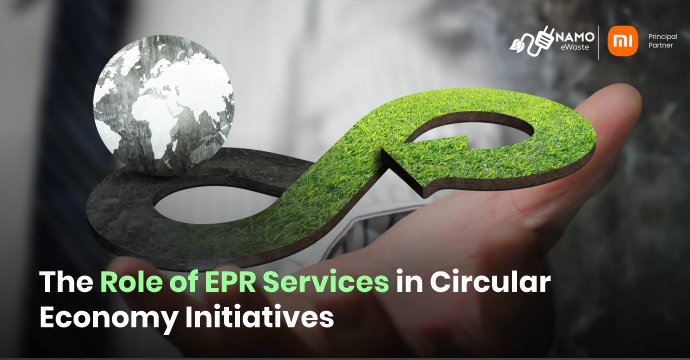
In today’s world, where environmental sustainability is becoming increasingly crucial, circular economy initiatives are gaining momentum. Extended Producer Responsibility (EPR) services are essential to these initiatives. In this blog, we will delve into the role of EPR services and their contribution to circular economy initiatives. Extended Producer Responsibility (EPR) services are playing an increasingly important role in driving sustainability and enabling circular economy initiatives around the world. As consumers and regulators demand more accountability from brands, EPR provides a framework for producers to take responsibility for their products at the end of their lives. This has powerful implications for reducing waste, retaining value, and creating a truly circular production system. But what exactly are EPR services, and why are they so critical for sustainability and the circular economy? What are EPR Services? Extended producer responsibility (EPR) policies make producers responsible for the end-of-life management of their products and packaging. Producers can fulfil their EPR obligations either individually or collectively through an authorised EPR service provider. EPR service providers manage end-of-life products and packaging on behalf of producers through activities like collection, sorting, recycling, and disposal. They handle the operational aspects of taking back products once consumers discard them and ensure proper recycling and disposal. EPR shifts the physical and financial burden of waste from municipalities and taxpayers onto producers. By making companies responsible for their products after consumers use them, EPR incentivizes sustainable design and drives innovation in recycling and recovery. Driving Higher Collection and Recycling Rates One of the most immediate benefits of EPR services is significantly higher recycling rates. With producers directly managing and financing waste collection, they are motivated to maximise recovery, retain material value, and reduce disposal costs. This results in higher collection rates and better sorting, which enables higher-quality recycling. Unlocking Innovation in Product Design EPR also creates an incentive for companies to design products that are durable, repairable, reusable, or recyclable. Since producers pay for the waste their products create, they aim to minimise end-of-life costs through sustainable design. This drives innovation in materials, disassembly, and recovery processes. We are already seeing the results, with brands reducing packaging, incorporating recycled content, avoiding hazardous chemicals, and enabling recycling or reuse. EPR provides a way for environmental considerations to shape business decisions at the product design phase itself. Collaboration Across Value Chains By bringing together stakeholders from across the product value chain, EPR systems enable collaboration for a circular economy. Producers, waste management companies, recyclers, policymakers, and consumers must work together to improve collection and develop sustainable products and recovery processes. This collaboration allows materials to be kept at their highest value for longer. It enables the partnerships and infrastructure required to transition from our current linear take-make-waste model to a circular production system. Compliance with Producer Responsibility While many leading brands have sustainability commitments, EPR mandates create a level playing field by requiring all producers to take responsibility for waste. This policy-driven approach harmonises efforts and prevents free riders who take advantage of voluntary efforts by others. Brands can leverage the compliance obligations, targets, and timelines created by EPR to accelerate their sustainability journeys. This structure enables brands to demonstrate their commitment to producer responsibility. Summing it up! The role of EPR services in circular economy initiatives cannot be overstated. By promoting waste reduction, recycling, and responsible disposal, EPR services align perfectly with the principles of sustainability in the circular economy. At Namo eWaste, we enable many of India’s leading consumer brands to establish EPR systems and meet their producer responsibilities. We provide full-service solutions covering the collection and recycling of packaging waste nationwide. By supporting EPR implementation, we aim to create positive change for the environment while helping brands show their commitment to sustainability. Connect with us to learn how we can assist you in your journey towards zero waste and a circular economy.
How India’s EPR Framework Caught the Attention of G20 Countries

India’s Extended Producer Responsibility (EPR) framework has gained significant attention from G20 countries due to its innovative approach to addressing the challenges of plastic waste and promoting a circular economy. The recent deliberations at the G20 Environment and Climate Sustainability Working Group Meeting in Gandhinagar highlighted the importance of global cooperation for an integrated circular economy[1]. Here’s a closer look at how India’s EPR framework has become a model for other countries and the key factors that have contributed to its success. Addressing the Challenges of Plastic Waste Generation The G20 discussions have emphasised the need for effective strategies to tackle the increasing generation of plastic waste. India’s EPR framework has been recognized as a comprehensive approach that holds producers responsible for the entire lifecycle of their products, including post-consumer waste management[1]. This approach ensures that the burden of managing plastic waste is shared among all stakeholders, leading to more sustainable and efficient waste management systems. “The circular economy is about resource efficiency that can improve our products and services but also ensure that there is minimal environmental impact while extracting the materials. Reusing, recycling and restoring are the best ways to continue our economic activity. The EPR framework presented explained the producer’s responsibility in creating a circular economy to which the G20 countries expressed great interest and were discussed in detail,” – Leela Nandan, Secretary Ministry, Environment, Forest and Climate Change. Key Achievements of India’s EPR Framework Electronic Waste Management: India’s EPR in waste management framework has led to a significant reduction in electronic waste ending up in landfills. Producers are now actively involved in collecting, dismantling, and recycling electronic products, ensuring the responsible disposal of hazardous materials. Plastic Waste Reduction: The extension of EPR to plastic products has contributed to a substantial decrease in plastic waste littering the environment. Producers have been incentivized to design products with recyclability in mind, leading to the development of eco-friendly packaging solutions. Boosting Circular Economy: India’s EPR framework has played a pivotal role in promoting a circular economy. The concept of product stewardship has encouraged manufacturers to design products with durability, repairability, and recyclability, reducing the overall environmental footprint. Integration of the 9Rs Principles To ensure the global applicability of the framework, the G20 has explored the integration of innovative concepts such as the 9Rs (Reduce, Reuse, Recycle, Recover, Redesign, Remanufacture, Repair, Refurbish, and Rethink). India’s EPR framework has already incorporated these principles, making it a valuable model for other countries looking to enhance their waste management strategies. Establishment of a G20 Resource Efficiency and Circular Economy Industry Coalition (RECEIC) The G20 has proposed the establishment of a Resource Efficiency and Circular Economy Industry Coalition (RECEIC) to facilitate international collaboration and knowledge sharing on circular economy initiatives. India’s EPR framework can serve as a blueprint for the RECEIC, showcasing the benefits of a comprehensive and inclusive approach to waste management. Engagement with Informal and Regional Platforms While several informal and regional platforms, such as the Platform to Accelerate a Circular Economy (PACE), already exist, the G20 has recognized the need for a formal mechanism dedicated to addressing the challenges posed by plastics. India’s participation in these platforms, along with its successful implementation of the EPR framework, positions the country as a key player in global efforts to combat plastic waste[1]. Fostering Partnerships: Government, Industry, and Civil Society Unite The success of India’s EPR framework can be attributed to the active participation of various stakeholders, including government officials, industry experts, and environmentalists. This multi-sectoral collaboration has helped in the development of a robust and effective waste management system, which can serve as a model for other countries seeking to enhance their sustainability efforts. Key Takeaways from the Presidency Document Multi-Stakeholder Collaboration: India emphasizes the importance of involving all stakeholders, including producers, consumers, recyclers, and regulatory bodies, in the EPR process. Collaboration is key to the success of any EPR framework. Innovation in Recycling Technologies: India highlights the need for innovation in recycling technologies to efficiently manage electronic and plastic waste. Investments in research and development have led to the development of state-of-the-art recycling facilities. Consumer Awareness: Educating consumers about the importance of responsible product disposal is a cornerstone of India’s EPR success. Awareness campaigns have been instrumental in changing consumer behavior. Transparency and Accountability: India’s EPR framework places a strong emphasis on transparency and accountability. Producers are required to report on their collection and recycling efforts regularly, ensuring a high level of accountability. India’s EPR framework has emerged as a leading example of how innovative policies and collaborative approaches can address the challenges of plastic waste and promote a circular economy. As G20 countries continue to work towards a more sustainable future, India’s experiences and best practices in EPR implementation will play a crucial role in shaping global strategies for waste management and resource efficiency. References: https://www.g20.org/content/dam/gtwenty/gtwenty_new/document/G20_ECSWG-Extended_Producer_Responsibility_for_Circular_Economy.pdf Citations: [1] https://t20ind.org/research/creating-a-g20-plastic-waste-response-framework-for-sustainable-consumption/
Ways to Reduce the Carbon Footprint of Laptops Through Proper IT Asset Disposal?
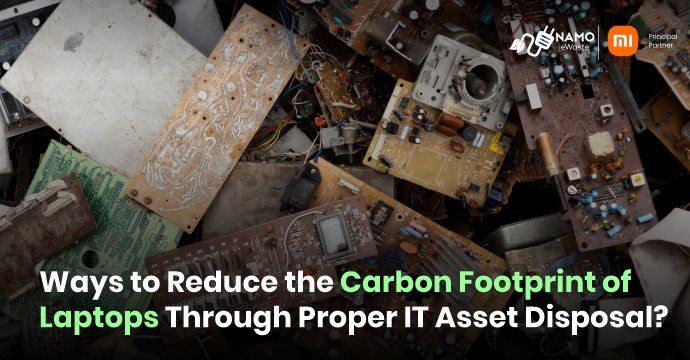
In today’s digital age, laptops have become an indispensable part of our lives. However, the production, use, and disposal of laptops contribute to carbon emissions and environmental degradation. To combat this issue, it is crucial for organisations and individuals to take proactive steps towards reducing the carbon footprint of laptops. One effective way to achieve this is through proper IT asset disposal. In this blog, we will explore several practical ways to reduce the carbon footprint associated with laptops and highlight the role of Namo eWaste Management Ltd. in implementing sustainable solutions. Extend the Lifespan of Laptops: One of the simplest and most effective ways to reduce the carbon footprint of laptops is by extending their lifespan. By properly maintaining and repairing laptops, organisations can maximise their usage before considering an upgrade or disposal. This approach reduces the demand for new laptops, thereby reducing carbon emissions associated with manufacturing and transportation. Implement Laptop Recycling Programs: Organisations should establish structured laptop recycling programs to ensure responsible disposal. Instead of throwing away old laptops, recycling allows for the recovery of valuable materials, reducing the need for raw resource extraction. Namo eWaste Management Ltd. offers comprehensive laptop recycling services, adhering to strict environmental regulations and certifications. By partnering with Namo eWaste, organisations can contribute to reducing their carbon footprint through proper IT asset disposal. Choose Energy-Efficient Laptops: When purchasing new laptops, opt for energy-efficient models that have earned energy certifications such as ENERGY STAR. These laptops are designed to consume less energy during operation, leading to reduced carbon emissions over their lifespan. Energy-efficient laptops not only save money on electricity bills but also help mitigate the environmental impact of laptop usage. Promote Remote Work and Virtual Meetings: Encouraging remote work and virtual meetings can significantly reduce the carbon footprint associated with laptop usage. By minimising the need for employees to commute, organisations can reduce transportation-related emissions. Virtual meetings also eliminate the need for travel, further reducing carbon emissions. Embracing remote work practices not only benefits the environment but also enhances work-life balance and productivity. Proper Disposal of Batteries: Laptop batteries contain hazardous materials that can harm the environment if not disposed of properly. Implementing battery recycling programs ensures the safe and responsible disposal of laptop batteries. Namo eWaste Management Ltd. specialises in the handling and disposal of hazardous materials, providing a reliable solution for organisations to dispose of laptop batteries in an environmentally friendly manner. Key Takeaways: Reducing the carbon footprint of laptops through proper IT asset disposal is a vital step towards a sustainable future. By extending the lifespan of laptops, implementing recycling programs, choosing energy-efficient models, promoting remote work, and properly disposing of batteries, organisations can make a significant impact on carbon emissions. Namo eWaste Management Ltd. emerges as a trusted partner in achieving these goals. With their expertise in responsible e-waste recycling, including laptops, Namo eWaste ensures that valuable resources are recovered and hazardous materials are handled safely. By collaborating with Namo eWaste, organisations can effectively reduce their carbon footprint and contribute to a greener and healthier planet. Choose Namo eWaste as your partner in reducing the carbon footprint of laptops through proper IT asset disposal. Together, we can make a tangible difference and work towards a more sustainable future!🌿
Comprehensive Guide to Reverse Logistics & Why Is It Important?

The process of managing the flow of goods and materials from the end consumer back to the point of origin is called reverse logistics. This process is also known as aftermarket supply chain management or reverse supply chain. The goal of reverse logistics is to optimise the value of returned products while minimising waste and environmental impact. In this blog, we will discuss the importance of reverse logistics and its benefits for organisations. Reverse Logistics Management Reverse logistics management involves the coordination of activities related to the reverse flow of goods, from customer returns to the point of origin. This includes activities such as product returns, refurbishment, repair, and recycling. Effective reverse logistics management can reduce costs, increase customer satisfaction, and improve sustainability. Importance of Reverse Logistics Reverse logistics is becoming increasingly important in today’s economy for several reasons. Firstly, it is an effective way to reduce waste and minimise the environmental impact of discarded products. By reusing and recycling materials, organisations can reduce their carbon footprint and contribute to a greener future. Secondly, reverse logistics can help organisations reduce costs and increase efficiency. By optimising the flow of returned products, organisations can minimise waste and improve the recovery of value from products that would otherwise be discarded. This can help organisations to improve their bottom line and reinvest the savings into other areas of the business. Thirdly, reverse logistics can improve customer satisfaction. By providing a convenient and efficient returns process, organisations can build trust with customers and improve their overall experience. This can lead to increased customer loyalty and repeat business. There are several benefits of reverse logistics strategy for organisations. These include: Cost Savings: By recovering value from returned products, organisations can reduce the costs associated with waste disposal and inventory management. Improved Sustainability: By reusing and recycling materials, organisations can reduce their environmental impact and contribute to a greener future. Improved Customer Satisfaction: By providing a convenient and efficient returns process, organisations can improve customer satisfaction and build trust with customers. Increased Efficiency: By optimising the flow of returned products, organisations can minimise waste and improve the recovery of value from products that would otherwise be discarded. Reverse Supply Chain The reverse supply chain is the network of activities involved in the reverse flow of goods, from customer returns to the point of origin. This includes activities such as product returns, refurbishment, repair, and recycling. The reverse supply chain is an important component of the overall supply chain, and effective management of the reverse supply chain can improve efficiency, reduce costs, and improve sustainability. Key Takeaways In conclusion, reverse logistics is an important aspect of supply chain management that involves the coordination of activities related to the reverse flow of goods, from customer returns to the point of origin. Effective reverse logistics management can reduce costs, improve sustainability, and increase customer satisfaction. By optimising the flow of returned products, organisations can minimise waste and improve the recovery of value from products that would otherwise be discarded. Organisations that implement a reverse logistics strategy can enjoy the benefits of cost savings, improved sustainability, improved customer satisfaction, and increased efficiency. Namo eWaste Management Ltd. is one of the leading companies in India that specialises in the responsible recycling of electronic waste, including the management of reverse logistics. If your organisation is looking to implement a reverse logistics strategy for the management of electronic waste, we can provide comprehensive and sustainable solutions. With our experience in managing large volumes of high-quality EEE waste and their ISO and r2 certifications, you can trust Namo eWaste to handle your electronic waste in an environmentally safe and responsible manner. Contact us today to learn more about their services and how they can help your organisation implement an effective reverse logistics strategy for electronic waste management.
How to Securely Dispose of IT and Media Assets

As our dependence on technology continues to grow, so does the amount of electronic waste we generate. From old laptops to outdated media devices, disposing of IT and media assets can be a challenge, especially when it comes to ensuring the security of sensitive data. At Namo eWaste, we are committed to ensuring that electronic waste is disposed of in a safe, secure, and environmentally friendly way. In this blog, we’ll explore some of the best practices for securely disposing of IT and media assets, and explain how Namo eWaste can help. IT and Media Assets: Tips to Dispose Securely disposing of IT and media assets is crucial to protecting your sensitive data and reducing electronic waste. By following these best practices, you can ensure that your old devices are properly disposed of and your data stays secure. Consider hiring a professional IT asset disposal service to handle the disposal process for you, and make sure to document the process for future reference. With these steps, you can dispose of your old IT and media assets with confidence, knowing that you’re doing your part to protect your data and the environment. Here are some tips on how to securely dispose of IT equipment and Media Assets: Backup your data Before disposing of any IT equipment or media assets, it’s important to back up any important data you may have stored on them. This includes files, photos, and any other data that could be compromised if the device falls into the wrong hands. Make sure to transfer all of this data to a secure location, such as an external hard drive or cloud storage service, before proceeding with the disposal. Erase your data Once you’ve backed up your data, the next step is to securely erase all of the data from the device. This can be done using a variety of methods, including overwriting the data multiple times, using specialised software, or physically destroying the device. If you’re not sure how to securely erase your data, consider hiring a professional IT asset disposal service to handle this step for you. Consider IT equipment recycling Recycling IT equipment is not only environmentally friendly, but it can also help ensure that your data stays secure. When you recycle your old IT equipment, the recycling company will dismantle the device and securely dispose of any data storage components. They will also recycle any usable parts, reducing the amount of electronic waste that ends up in landfills. Properly dispose of media assets Media assets, such as CDs, DVDs, and flash drives, can also contain sensitive data that needs to be securely disposed of. Shredding, crushing, or degaussing the media can all be effective ways to ensure that the data is irretrievable. Again, consider hiring a professional asset disposal service to handle the disposal of your media assets. Document the disposal process Finally, it’s important to document the disposal process to ensure that you can provide evidence of proper disposal in case of any audits or legal requirements. Keep a record of the disposal process, including the date and method of disposal, as well as any certificates or other documentation provided by the disposal company. Why Namo eWaste for recycling IT assets? At Namo eWaste, we believe that secure and environmentally friendly disposal of IT and media assets is a responsibility that we all share. Our team is committed to providing safe and efficient disposal solutions that meet the highest standards of data security and environmental sustainability. By choosing Namo eWaste, you can rest assured that your electronic waste is being disposed of in a secure, eco-friendly, and socially responsible manner. Join us in the fight against electronic waste and choose Namo eWaste for all your electronic waste disposal needs. Together, we can make a difference!
Positive Impact of The Circular Economic Model on Climate Change
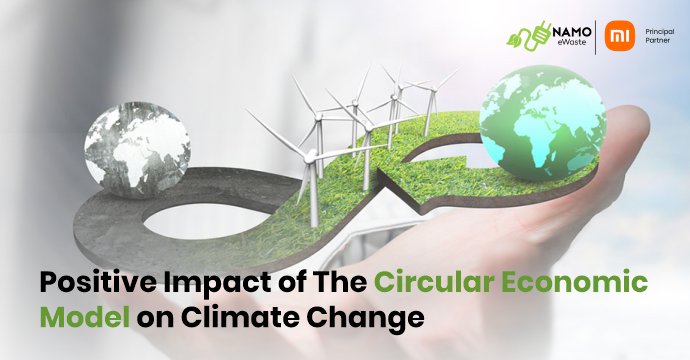
As the world continues to face the challenge of climate change, it is clear that we need to shift our current economic model to a more sustainable one. The Circular Economic Model is one such model that is gaining traction around the world for its ability to reduce waste, conserve resources and reduce greenhouse gas emissions. In this blog, we will explore the benefits of the Circular Economic Model and its positive impact on climate change. The Need for a Sustainable Economic Model The world is facing an unprecedented challenge in the form of climate change. The increasing concentration of greenhouse gases in the atmosphere is causing temperatures to rise, leading to more frequent and severe weather events, rising sea levels, and damage to ecosystems. One of the main drivers of climate change is our current economic model, which relies on a linear approach to resource use. In this model, resources are extracted, processed, and disposed of at the end of their useful life. This approach leads to waste, pollution, and the depletion of natural resources. To address the challenges of climate change, there is a growing need for a sustainable economic model. One such model is the Circular Economic Model. This model aims to keep resources in use for as long as possible, extracting the maximum Circular Economic Model: What is it? The Circular Economic Model is an economic model that aims to keep resources in use for as long as possible, extracting the maximum value from them before ultimately recovering and regenerating them. The circular model of economy differs from the traditional linear model, which takes a ‘take, make, dispose’ approach to resources. In contrast, the circular economic model is designed to be restorative and regenerative by design. Circular Economy: Benefits There are many benefits of circular economy but these few are the most important: Resource Conservation: The Circular Economic Model focuses on reducing waste by keeping resources in use for as long as possible. This reduces the need for new resources and therefore reduces the number of natural resources extracted from the environment. Lower Greenhouse Gas Emissions: The Circular Economic Model has the potential to reduce greenhouse gas emissions by reducing waste, promoting energy efficiency and encouraging the use of renewable energy sources. New Business Opportunities: The Circular Economic Model offers new business opportunities for companies that can create innovative products and services that fit within this model. By creating value from waste, companies can generate revenue while reducing their environmental impact. Job Creation: The Circular Economic Model has the potential to create jobs in areas such as recycling, remanufacturing, and repairing. These jobs are typically local and can help stimulate local economies. The Impact of Circular Economy:Climate Change The impact of the Circular Economic Model on climate change is significant. By reducing waste and greenhouse gas emissions, the Circular Economic Model can help to mitigate the impacts of climate change. For example, the use of renewable energy sources, such as wind and solar power, can help to reduce the amount of greenhouse gases emitted by the energy sector. Additionally, the Circular Economic Model can help to reduce emissions in the manufacturing sector. By promoting the use of recycled materials and remanufacturing, the amount of energy needed to produce new products can be reduced. This leads to a reduction in greenhouse gas emissions and a more sustainable production process. Ending Note… The Circular Economic Model offers a positive solution to the challenges we face with climate change. By reducing waste, conserving resources, promoting energy efficiency and creating new business opportunities, this model has the potential to create a more sustainable future for us all. As we continue to face the challenges of climate change, it is clear that the Circular Economic Model has a vital role to play in creating a more sustainable future for our planet. Circular economy is not just a concept, but a real-world solution that can benefit our planet and future generations. NAMO, as an e-waste recycling company, is committed to contributing to the circular economy model. By recovering valuable resources from electronic waste, we reduce the need for extracting new materials, conserve natural resources, and promote a sustainable production process. Our efforts not only help in waste reduction but also generate new job opportunities and promote a sustainable business model. By creating a closed-loop system for electronic waste, NAMO aims to create a more sustainable future, in line with the principles of the Circular Economic Model.
5 Steps to Starting an Electronics Recycling Program at Work
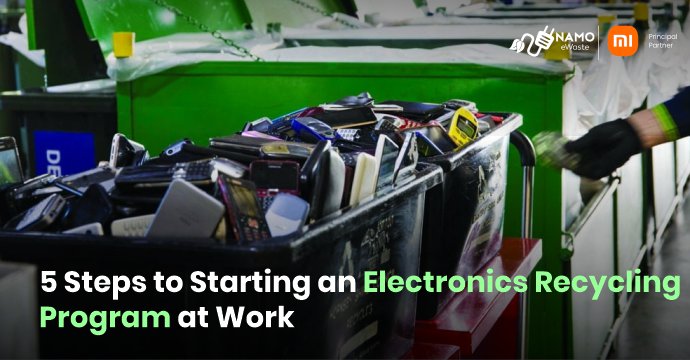
In today’s digital age, businesses are heavily dependent on technology to function and operate. This means that when electronics become outdated or are no longer useful, they are often discarded without a second thought. However, the improper disposal of electronics can be harmful to the environment and pose a threat to data security. Starting an electronics recycling program at work is an excellent way to mitigate these risks. Here are 5 steps to help you get started. Know What Electronics to Recycle Before starting an electronics recycling program, it’s essential to understand what kind of electronics are recyclable. In general, you can recycle obsolete IT equipment such as outdated computers, old cellphones, smartphones, and tablets, fax machines, wired landlines, and flash drives. Other types of recyclable electronics include television sets, DVD/VHS players, projectors, radios, circuit boards, and audio video equipment. If you’re unsure about an old device in your office, simply call your local electronics recycling facility to see if it’s recyclable. Learn How to Dispose of Electronics Properly Once you have gathered all the electronics, it’s time to read up on the proper protocol before getting rid of them. You’ll need to decide how you will dispose of the electronics. You have three main options: donate, sell, or recycle. After you choose what you’ll do with the equipment, you should wipe or destroy any data found in each device. This step is crucial in protecting your data and mitigating the risk of data breaches. Protect Your Data Guarding your data is arguably the most critical part of any electronics recycling program. To do so, you’ll need to either wipe private information from drives or completely destroy the data. It’s best to cover all your bases and permanently destroy the data. A professional electronics recycler will demolish it for you and send you a certificate of proof. This will give you peace of mind that your private information is truly safe and secure. Set Basic Criteria for Your Plan Next, create a corporate electronics recycling plan with step-by-step electronics recycling solutions to jump-start your initiative. You’ll want to set expectations for your team that are measurable and easy to meet. Some examples may include specifying a distinct location to store electronics before they are recycled, appointing team leaders to collect the devices, giving presentations that discuss the benefits of recycling, explaining why you are incorporating electronics recycling solutions at work, and making annual benchmarks for the collection and disposal of electronics. Choose the Right Electronics Recycling Company The last but not least step is to research electronics recycling companies to send your old devices to. A good electronics recycling company will pick up your electronics, send proof of data destruction, obtain the proper certifications for recycling, and use eco-friendly practices. Furthermore, you should always check company reviews before you send your electronics to them. If the facility has little to no reviews or the majority of them are negative, then you should steer clear from them. In conclusion, starting an electronics recycling program at work is an excellent way to mitigate environmental harm and data security risks. By following the above 5 steps, you can create a successful and sustainable program that benefits not only your business but also the environment. Remember, the easier and more enticing you make it to recycle, the more success you’ll see. And we can help you implement this plan! NAMO is an excellent choice for businesses of all sizes. With our commitment to sustainable and secure recycling practices, we can help you dispose of your old electronics responsibly while protecting your sensitive data. Our team of experts has years of experience in the electronics recycling industry and will work with you to develop a customised plan that meets your unique needs. Whether you need assistance with IT equipment recycling or data destruction, we can help. So, if you’re ready to start your electronics recycling program at work, contact us today.
Metal Recovery Through E-Waste: Mining Value From Old Electronics

Electronic waste, commonly known as eWaste, has become a significant problem globally. As the production of electronic products increases, so does the amount of eWaste generated. E-waste recycling has become an essential tool in managing this problem. Among the many benefits of eWaste recycling, the recovery of precious metals is one of the most significant. Precious metals such as gold, silver, copper, tin, and zinc are present in most electronic products, from cellphones to televisions. These metals are highly valuable, and recovering them from eWaste can have numerous benefits, including conserving natural resources, reducing pollution and greenhouse gas emissions, and providing an alternative source of scarce raw materials. Metal recovery is the process of reclaiming metals from waste products such as eWaste. This type of recycling has numerous benefits, including environmental, economic, and public health advantages, making it an excellent option for businesses and households with electronic waste. Metal recovery involves separating and collecting precious metals from discarded electronic products that would otherwise be disposed of in a landfill or incinerated. This process prevents these metals from entering the environment and reduces our reliance on primary minerals mined from the ground. The benefits of metal recovery from eWaste are many. Metal recycling can dramatically benefit the economy by creating new jobs in the recycling industry and generating revenue for investors. Recovering metals from electrical components during eWaste recycling produces valuable raw materials while saving energy and reducing pollution associated with mining operations. Moreover, manufacturers can reduce costs without sacrificing quality or efficiency by recycling these materials back into production processes. Metal recovery also has a positive impact on the environment. Collecting, sorting, and extracting metals from electronics helps decrease the number of toxins released into the air, ground, or water from burning or landfilling these materials. It also prevents hazardous substances like lead and mercury from entering our food chain. Recycling also reduces energy consumption since extracting metals from recycled products requires less energy than producing them from raw materials. Metal recovery from eWaste also helps conserve energy. Recovering valuable metals requires less energy compared to making them in a factory setting, which can result in significant energy savings. Moreover, metal recovery preserves precious natural resources. As the demand for electronic products increases, so does the need for raw materials. The extraction and processing of these raw materials lead to significant environmental damage. Keeping these natural resources is a critical concern today as these natural resources are scarce, and metal recovery can be an effective way of achieving this goal. Recovering valuable metals from these discarded electronics helps protect natural resources through mining activities. In conclusion, metal recovery is an incredibly beneficial practice, and eWaste recycling is an essential tool for protecting our environment and conserving finite resources. At NAMO, we provide fast, reliable, cost-effective metal recovery solutions. Our services can help you with the benefits of eWaste recycling, making the most of old electronics, and keeping them out of landfills. By understanding the benefits of metal recovery from eWaste, we can work towards a more sustainable future and unlock potential revenue streams.
Data Security and The Advancement of eWaste Activism

The importance of data security has become increasingly evident, as cybercrime continues to rise and data breaches become more common. However, data security is not just a concern for companies and individuals in the digital realm. It also has significant implications for the disposal of electronic waste, or eWaste. With the growing amount of eWaste generated every year, it is essential to ensure that data security measures are in place when disposing of electronic devices. The Importance of Data Security Data security refers to the protection of digital data from unauthorised access, use, and theft. As our lives become more connected to the digital world, the amount of data we generate and store continues to increase. This includes personal information such as bank account details, social security numbers, and even health records. Therefore, the importance of data security cannot be overstated. Hackers and cybercriminals can gain access to this sensitive data if it is not disposed of properly. Data breaches can have severe consequences, such as identity theft, financial loss, and reputational damage. Therefore, it is essential to ensure that measures for data security in eWaste are in place before disposing of any electronic devices. Data Security in eWaste E-waste contains a vast amount of sensitive data that, if not disposed of correctly, can end up in the wrong hands. For example, a discarded computer or smartphone can contain personal information such as login credentials, financial information, and even confidential business information. To prevent this from happening, it is essential to ensure that measures for data security in eWaste are in place when disposing of eWaste. This includes wiping the device clean of any data or physically destroying the device to prevent any potential data recovery. Many organisations have implemented policies and procedures to ensure that data security in eWaste is maintained when disposing of eWaste. Advancement of eWaste Activism E-waste activism is a growing movement that seeks to address the issue of electronic waste and its impact on the environment and society. With the increasing awareness of the harmful effects of eWaste, there has been a push towards more sustainable and responsible disposal methods. One of the key areas of focus for eWaste activism is data security. Many organisations are now implementing measures to ensure that data is securely disposed of when electronic devices reach the end of their useful life. This includes implementing data wiping procedures, physically destroying devices, and partnering with reputable eWaste recyclers. In addition to data security, advancement in eWaste activism has also led to advancements in recycling technologies. With the increasing amount of eWaste generated every year, there is a growing need for more efficient and sustainable recycling methods. This has led to the development of new technologies that can extract valuable materials from eWaste while minimising the environmental impact. In conclusion, data security is an essential aspect of eWaste activism. As the amount of electronic waste continues to increase, the importance of data security measures becomes increasingly important. By implementing proper data security measures, organisations can ensure that sensitive data is not compromised when disposing of electronic devices. Furthermore, eWaste activism has led to advancements in recycling technologies, which can help to minimise the environmental impact of electronic waste. It is essential to continue supporting eWaste activism and promoting responsible eWaste disposal practices to protect our data and the environment. NAMO is an eWaste recycling company that understands the importance of data security and the impact of electronic waste on the environment. Our mission is to provide sustainable and responsible solutions for the disposal of electronic waste, while ensuring that data security is maintained at all times. At NAMO, we implement strict data wiping procedures and use the latest technologies to ensure that sensitive data is securely disposed of. We also partner with reputable eWaste recyclers to ensure that electronic waste is recycled in a way that minimises the environmental impact. As a company committed to eWaste activism and advancement in eWaste activism, we are constantly striving to improve our recycling technologies and find new ways to minimise the impact of electronic waste on the environment. By working together, we can promote responsible eWaste disposal practices and protect our data and our planet for future generations.
Sustainable Manufacturing Strategy for Eliminating eWaste by Engineers
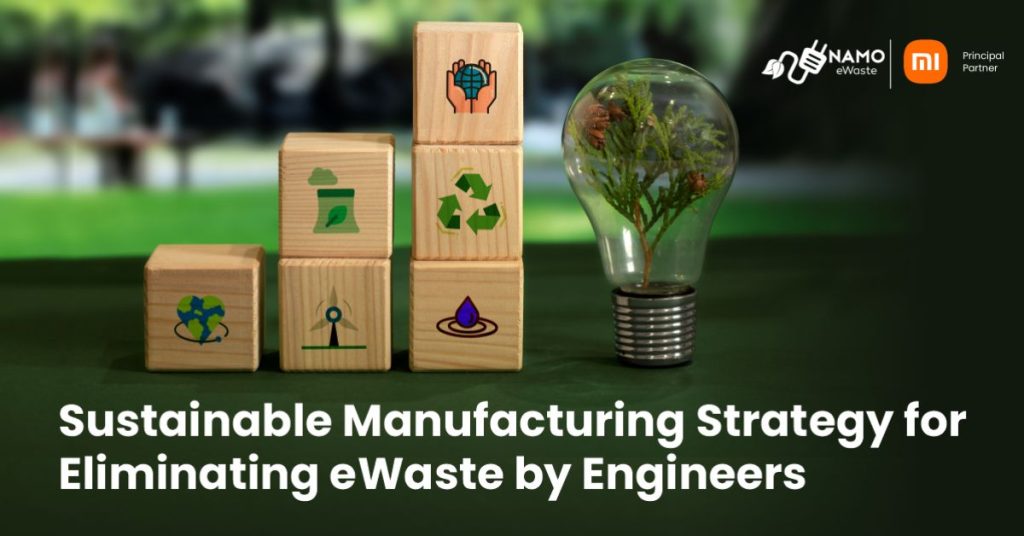
As our reliance on electronic devices continues to increase, so does the amount of eWaste generated each year. To combat this issue, engineers have a crucial role to play in developing sustainable manufacturing strategies that reduce waste and promote a circular economy. By implementing innovative technologies and designing products for disassembly and recycling, engineers can help eliminate eWaste and create a more sustainable future. One key strategy for reducing eWaste is to design products that are made to last. This means using durable materials and designing devices that are easy to repair and upgrade. When products are built to last, consumers are less likely to replace them frequently, which can help to reduce the overall amount of eWaste generated. Another strategy is to use environmentally friendly materials in the manufacturing process. For example, engineers can choose materials that are biodegradable or can be easily recycled. This can help to reduce the amount of waste that ends up in landfills and conserve natural resources. In addition to using sustainable materials, engineers can also incorporate eco-friendly manufacturing processes into their operations. For example, they can implement energy-efficient production methods or use renewable energy sources to power their factories. This not only helps to reduce the environmental impact of manufacturing, but it can also save money on energy costs in the long run. Another important strategy is to develop take-back programs or recycling initiatives for end-of-life products. This means creating systems for consumers to return their old devices so they can be properly disposed of or recycled. Many electronics manufacturers have already implemented take-back programs, but there is still a long way to go in terms of making these programs more accessible and widespread. Finally, engineers can also promote the use of circular economy principles in the manufacturing process. The circular economy is an economic model that prioritises the use of renewable resources and the minimization of waste. By designing products that are made to be recycled and implementing closed-loop manufacturing processes, engineers can help to reduce the amount of eWaste generated and conserve natural resources. Overall, there are many strategies that engineers can use to help eliminate eWaste and promote sustainable manufacturing. By prioritising durability, using eco-friendly materials and processes, implementing take-back programs and recycling initiatives, and promoting circular economy principles, we can work towards a more sustainable future. It is engineers’ responsibility to take a leadership role in developing sustainable manufacturing strategies that protect our planet and support a healthy, thriving society. In conclusion, it is high time for engineers and manufacturers to adopt sustainable manufacturing strategies to combat the eWaste crisis. Additionally, by partnering with recyclers and engaging in public education campaigns, engineers can increase awareness of the importance of responsible eWaste disposal and motivate consumers to adopt more sustainable practices. In the end, it is the responsibility of everyone to work together to address the issue of eWaste. Whether it is through designing more sustainable products or properly disposing of our electronics, we all have a role to play in creating a cleaner, healthier planet. As we move towards a more sustainable future, let us all commit to doing our part in eliminating eWaste and building a better tomorrow for ourselves and future generations.

